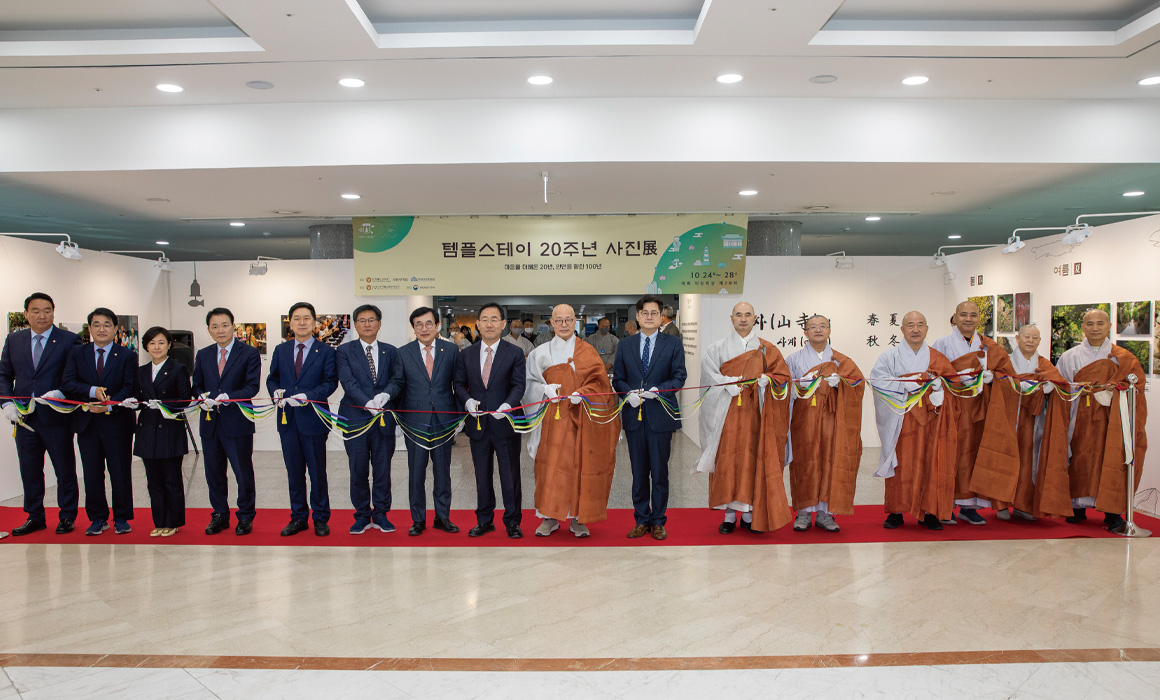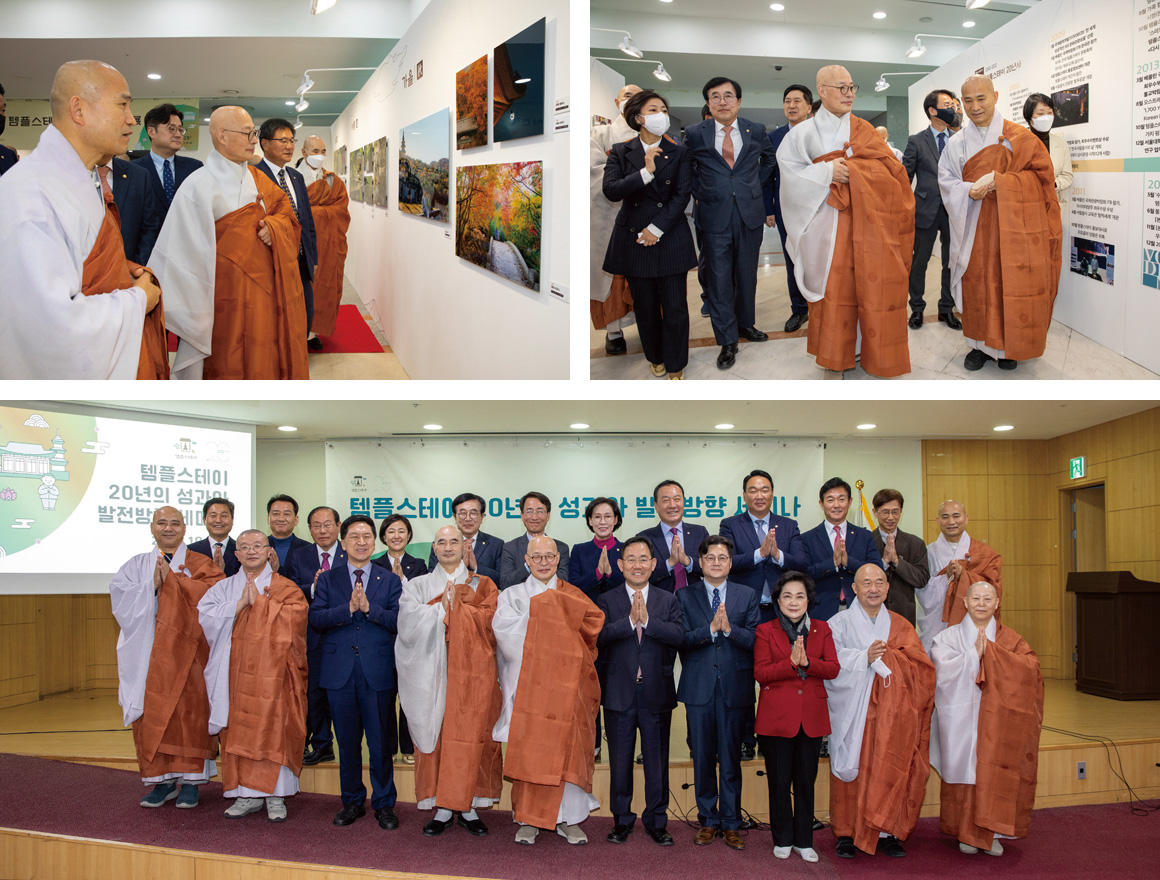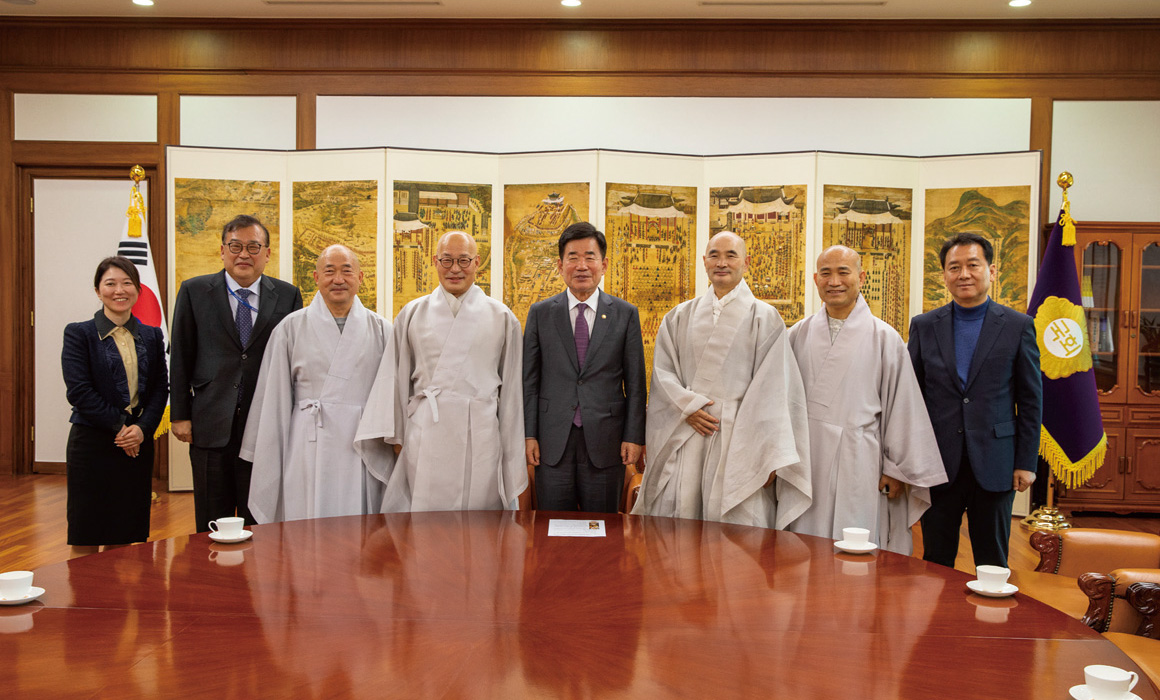Why Templestay Went to the National Assembly
Praying for a Sound Future for Templestay
Text by Editorial Staff Photo by Ha Ji-kwon

On Oct. 24, in the lobby and in a small meeting room at the National Assembly Members’ Office Building, an exhibition was held to showcase the 20-year history of the Templestay program, in addition to a seminar titled “Achievements of 20 Years of Templestay and Its Direction of Development.”
In the audience were abbots from 30 plus Korean temples, Templestay guiding monks, and other concerned parties.
A number of National Assembly members attended despite their upcoming busy schedule to inspect government offices, as well as figures from diverse walks of life who hoped for a sound future for the Templestay program.
Templestay’s achievements over the past 20 years are outstanding in terms of quantitative data which indicate that the number of Templestay temples increased from the initial 33 to 142 temples, and the program has logged about 6 million participant days with foreigners occupying 11%. However, the aforementioned seminar focused on the qualitative changes behind these quantitative changes, and on how the significance and values of Templestay have evolved. The seminar is significant in that it provided a platform for discussion based on in-depth analysis of data.

Into a Pinnacle of Korean Culture beyond Religious Boundaries
Templestay’s raison d'etre and its values are evident considering that it began with a government supported project to make traditional temples available as accommodations in preparation for the 2002 FIFA World Cup, and government’s consistent financial support has continued for the past 20 years. In the seminar’s first presentation, Prof. Chun Byung-gil (Division of Hotel, Tourism & Foodservice Management at Dongguk University) said that Templestay is now perceived as an opportunity for everyday citizens and foreigners to experience Korea’s distinctive culture regardless of religious affiliation. This means public perception has changed. He further analyzed that along with the Templestay program, temple food has become the center of “K-food” which preserves the essence of traditional Korean culture.
In 2009, Templestay was chosen by the Organization for Economic Co-operation and Development (OECD) as one of the five most successful tourist programs in the world. And in 2010, it was chosen by Korea’s Presidential Council on Nation Branding as one of the ten major iconic programs to represent Korea. Both facts testify that the value of Templestay is more aptly recognized overseas. Yu Hong-jun, an art historian, once declared, “Korea is a country of mountain temples,” meaning that mountain temple culture—which has cultivated a prospering Buddhist culture within a distinctive natural environment—is the supreme embodiment of Korean culture.
As the best way to experience this culture, Templestay is now recognized globally. A significant part of this success can be attributed to Templestay’s astute operation which strives to embrace diversity by overcoming religious exclusivity. This is clearly confirmed by the significant increase of non-Buddhist participants. Based on these achievements, Prof. Chun said that “the realization of citizen happiness through healing and the pursuit of sustainability” must be a part of the vision and goal required by Templestay. As a specific action plan, he proposed: acquiring a stable and expert working staff, establishing a world-class quality control system, and developing specialized programs for the social/public good.

Revisiting Templestay’s Original Mission
Part 2 of the seminar was opened by Prof. Lee Gyu-min (Dept. of Food Service Management at Kyung Hee University) with a presentation titled “Performance of Temple Food and Its Future Direction.” He emphasized that while Templestay has limitations in terms of space and accessibility, temple food—which occupies a prominent place in Korean traditional food culture—can be an asset to the Templestay program. In 2011, the first two temples designated to offer specialized temple food programs were Geumsuam and Yeongseonsa. Today that number has expanded to 15 temples. Of these, 11 temples operate both a Templestay and a temple food program. Prof. Lee said that temple food and baru gongyang (formal monastic meal)—both of which have been passed down as a part of Buddhist practice at temples—are recognized as an alternative food culture that is also eco-friendly. He further shared his opinion that as a vegan food, temple food will play an important role in the future of humanity.
A discussion session was then held moderated by senior researcher, Kim Sang-tae (Korea Culture and Tourism Institute). Ven. Seonjae, a temple food master, emphasized the importance of preserving and sharing the spirit of baru gongyang whose spirit has been preserved by Korean monastics. She added that in the climate change crisis we all face in the 21st century, temple food is a food culture that holds the promise of sustainability. She also reiterated that now is the time we should revisit the original spirit of Templestay and temple food.
President Kim Jong-deok (Slow Food Korea) indicated that a cultural approach is preferable to a business approach for the Templestay program. Prof. Sim Won-seop (Dept. of Tourism Management, Mokpo National University) stated that academic research is needed to find out who comes to Templestay and why, and that this data should be a new starting point for any future endeavors.
Ven. Hawon, abbot of Manggyeongsansa Temple and a member of the Templestay Expert Committee, gave more concrete directions based on his personal experience as a guide for the Templestay program. He proposed increasing the number of Templestay returnees by: changing the reservation system, developing a different program tailored for the MZ generation, and cultivating a specialized workforce by establishing a "Templestay Academy" (tentative name).

Buddhism’s Proactive Fulfillment of Social Responsibility
Before the opening of the seminar, an opening ceremony for a photo exhibition was held in the lobby of the National Assembly Members’ Office Building to showcase the past 20 years of Templestay’s evolution. Beginning from the first Templestay program held in May 2002 at Jikjisa Temple for foreign diplomats in Korea, Templestay’s history was presented in a well-organized fashion. Ven. Wonmyeong, director of the Cultural Corps of Korean Buddhism (hereafter “Corps”), said, “This photo exhibition is a good opportunity to look back at the 20-year history of the Templestay program. It is also a venue to meet again the many people involved in Templestay, to see the beautiful landscapes of mountain temples in all four seasons, and appreciate the many award-winning artworks submitted for the ‘Public Competition for Templestay’s 20th Anniversary.’ I hope this exhibition can help enhance people’s understanding of Templestay greatly.”
Ju Ho-young (president of the National Assembly’s Perfect Enlightenment Association and floor leader of the People Power Party) said that financial support for the Templestay program should be regarded not as support for a specific religion but for Korean traditional culture. Chairman Hong Ik-pyo (Culture, Sports & Tourism Committee of the National Assembly) mentioned that recently, the Corps had put the value of public service into action by providing free Templestay programs for the handicapped, multicultural families, and the underprivileged.
Attending both the opening ceremony and the seminar, Ven. Jinu, president of the Jogye Order of Korean Buddhism, said in his opening speech, “Although we enjoy material abundance, we are faced with the critical issues of our time, such as social conflict and anxiety, and environmental pollution. Templestay will fulfill the social responsibility of Buddhism by acting as a refreshing rain that heals the suffering of Koreans and global citizens.”





